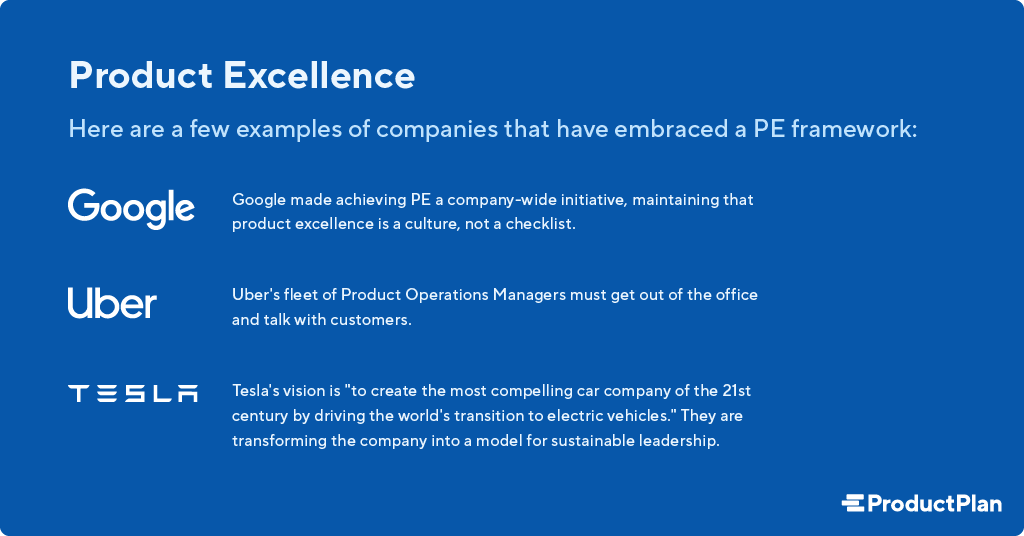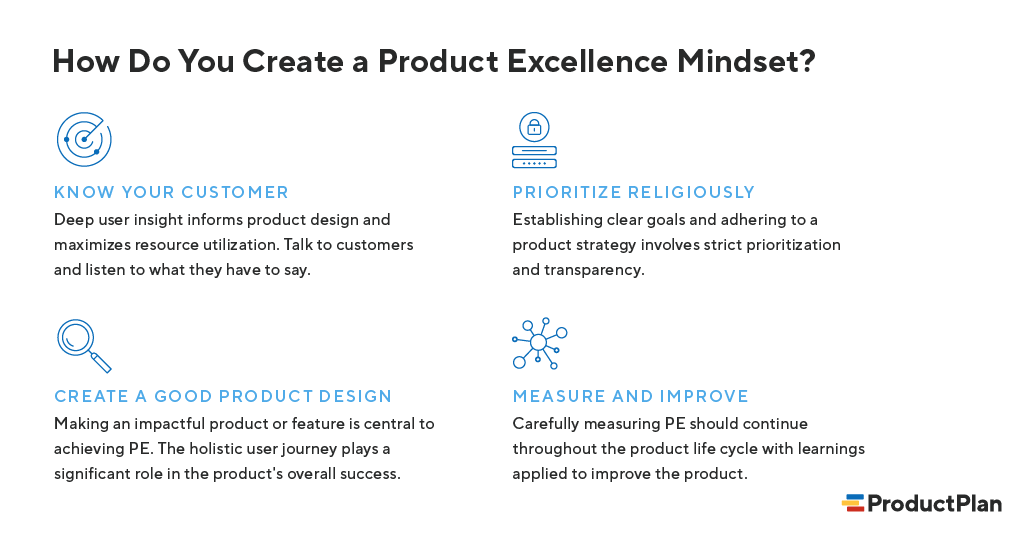What is Product Excellence?
Product excellence is a customer-focused framework. The framework helps develop a significant and impactful product or feature.
Achieving product excellence (PE) begins with keen user insight. You must know what customers want, anticipate what to need, and understand how they use the new product or feature. This in-depth customer knowledge informs good product design. Good design reduces the resource drain of developing a feature or product.
Routine and repeatable
PE provides a definite competitive advantage enabling organizations to innovate at a faster pace than ever before. Unlike an Agile-type approach that prizes rapid innovation, incremental progress, and learnings based on shorter feedback loops. PE strives to deliver the best solution right away.
Achieving this requires a systematic, comprehensive approach to discovery and research that analyzes opportunities in inconsistent formats. Making this a routine part of the product definition and development process increases stakeholders’ comfort level. It can lead to faster, easier alignment and fewer digressions and disagreements. Prioritization and implementation tend to be the two areas of dispute.
Strong customer relationships, a deep understanding of personas and preferences, and multiple channels to tap for input and feedback facilitate the information-gathering components of product excellence. With user base-ready feedback, the team can quickly evaluate which opportunities demand their attention. Moreover, they can define what problems require a resolution to add value.
Loved by industry leaders
Here are a few examples of companies that have embraced a PE framework:

Of course, not every product achieves PE, and sometimes failure is spectacular. Here’s a list of 155 product flops.
How Do You Create a Product Excellence Mindset?
Creating a PE mindset involves four key steps:

Staying grounded in strategy and avoiding scope creep
PE’s focus on customer satisfaction could lead the product astray. And it’s certainly true that a PE-led product will sometimes add functionality no one predicted.
But PE doesn’t mean anything the customer might want or need automatically ends up in the product. The product strategy and mission must always be the core guiding principles when prioritizing, despite how eager a customer maybe for something new.
No product can be all things to all people. Even high-performing PE teams still have limited bandwidth and resources. Their new ideas can align with the lens of the product’s purpose. S The addition of value to a product needs to remain relevant to the core product experience. The product should address the customer’s problems, as well.
Collecting and analyzing the correct data
While qualitative research plays an immense role in guiding decision-making in PE, practitioners must also tap into the vast reservoirs of available user data to spot trends, identify trouble spots, and quantify opportunities. Individuals make proper instrumentation standard operating procedures for every product experience (including discovery, conversion, and onboarding).
At the same time, companies using PE run the risk of drowning in data that clouds decisiveness and grants ammunition to contrarian stakeholders. Finding the balance between having enough evidence to support recommendations and overwhelming everyone with too much of it can make the difference between an organization that dabbles in PE and one that lives it.
Of course, once implementation occurs, its success must be measured, so there’s a need to aggregate and assess the relevant data to gauge that success or determine if additional work in that area could further enhance the customer experience to achieve the desired result objectives.
Product roadmaps key to achieving product excellence
Going to market quickly with a great new product or feature doesn’t happen without the vision and leadership of a highly effective product manager. They must be able to articulate that leadership and vision efficiently to different groups and stakeholders. Therefore, a shared strategic product roadmap plays a central role in keeping stakeholders on the same page regarding all aspects of product development and speeds development cycles.
Visual, goal-driven product roadmaps serve PE-oriented organizations best for multiple reasons. They provide structure and a vision to propel the organization forward. But they’re not constrained with specific details, dates, and deadlines that may lose relevance or importance as new customer intelligence rolls into their queue.
Using themes to denote the overall general priorities for the product, the organization can scout which specific functionality in that area most benefits users, creating a solid backlog of related items ready for implementation when the time comes. Themes allow for alignment around what’s critical for the product’s success without being overly prescriptive about the specifics.
The roadmap can also factor in technological advancements leading directly to customer value. Tech for its own sake is irrelevant from the user’s perspective. Still, if a newly available solution solves core user problems, the team can carve out a space for integration and implementation.
Running and maintaining product excellence.
PE is a mindset that becomes a permanent part of the company culture beyond any short-term gains. This emphasis on PE helps increases shareholder value, energizes employees and customers, and builds brand strength. But to be successful, PE must permeate the entire product creation process.
Organizations embracing PE also take a proactive approach to introduce new functionality and capabilities. Instead of waiting for customers to ask for something new, PE practitioners know their customers and market so well they anticipate those needs before they are in crisis or can fully articulate them. With stakeholders in the loop, the organization can adopt innovations that remain one step ahead of user needs and the competition.
New features are sketched out and illustrated in prototypes to gauge the response and get customer validation. They quickly deliver to a delighted user base thrilled by having their lives and jobs made easier with these valuable additions. These educated guesses should remain safe bets based on the diligent ongoing research of product and UX teams, limiting any time or money wasted on enhancements that see little adoption.
PE also relies on products built with flexibility and modularity. It’s critical that discrete areas can be changed, updated, or even removed without derailing the entire product development pipeline. PE demands technical planning and architecture capable of rapidly introducing new things without causing disruptions elsewhere in the product ecosystem.
Creating closer ties to sales and marketing
While product management must always remain aligned with engineering to understand what’s possible, PE also requires a robust and collaborative relationship with those positioning and selling the product. Not only will those colleagues have valuable customer insights to share that further inform concept development, but their actions are also critical to the success of new capabilities as they roll out.
How the product’s features and functionality are discussed, named, exposed, and priced all contribute to the perception of the product’s value. They are creating that emotional bond between products and customers fuels the continual feedback loop enabling ongoing PE.
Additionally, the sales and marketing team must adapt their pitches. Their materials and messaging need to reflect the current state of the product. With so much rapid iterative change, communication is critical to ensure all stakeholders align on what’s in the works and what’s to come.
Start Building Beautiful Roadmaps, From Product Manager to Product Leader.
